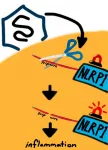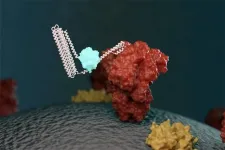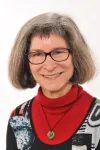(Press-News.org) An interdisciplinary team of the Institut national de la recherche scientifique (INRS) used an innovative imaging technique for a better understanding of motor deficits in Amyotrophic Lateral Sclerosis (ALS). The researchers were able to follow the escape behaviour of normal and disease zebrafish models, in 3D. Their results have recently been published in Optica, the flagship journal of the Optical Society (OSA).
Professor Jinyang Liang, expert in ultra-fast imaging and biophotonics, joined an effort with Professor Kessen Patten, specialist in genetics and neurodegenerative diseases. The two groups were able to track the position of zebrafish in real time and capture the 3D motion, using a special imaging technique called dispersion-eliminated coded-aperture light field, or DECALF.
"It is a unique feature for the analysis of animal behaviours from a neurodevelopment perspective. Otherwise, we would only be able to see the movement in a plane. Losing one dimension can be misleading when studying the movement. You may think zebrafish move one way, but the reality is quite different," said the expert.
Their data revealed asymmetrical orientation angles of the left and right fins, indicating drastic changes in direction during the normal zebrafish' s escape from the stimulus. In contrast, the diseased zebrafish model showed slow responses and limited movement capacity due to motor deficits.
Conventional light field cameras capture the information not only in x and y, but also the angle at which the light rays are coming from. This way, you can trace them back to focus on where you want. According to Professor Liang, the problem with this technology is the tradeoff. The image can have a high spatial resolution or a high angle resolution, but not both. The solution for this is the coded aperture light field (CALF) imaging, which can be achieved using digital micromirror devices (DMD).
An Innovative Design
The DMD acts like a diffraction element and separates the white light into a rainbow. A DMD alone cannot use it with ambient light or sunlight. "You could always use a single-wavelength light, but it leads to other disadvantages, since the colour of the light may interfere with the nerve system and affect the experiments. For example, red light could make people aggressive, and blue light is also known to affect the mood," Professor Liang explains.
To bypass this limitation, the research team used a second DMD to cancel the rainbow induce by the other one. "We are the first to use this design to manage the colour dispersion within the entire visible spectrum, which allows us to use white light for this experiment," says Dr. Jingdan Liu, a postdoctoral fellow at INRS and the first author of this paper. "DECALF imaging could open up a new avenue for neuroimaging. For example, we could use this system to see neurons' activity. We could track the emitted light when a neuron 'fires' to know where the neuron is located in the brain and its connectivity," says Professor Liang.
"Thanks to the work of Professor Liang, we were able to see the macroscopic behaviour of zebrafish with ALS-like symptoms. We could go even further in the study of this disease by looking at the microscopic scale.Using this innovative imaging approach, we could learn about what is happening in the neural system in normal and disease states in a non-invasive manner," Professor Patten says.
INFORMATION:
About the Study
The article "Coded-aperture broadband light field imaging using digital micromirror devices", by Jingdan Liu, Charlotte Zaouter, Xianglei Liu, Shunmoogum A Patten and Jinyang Liang, was published in the February 2021 issue of the journal of Optica. Researchers received financial support from the Natural Sciences and Engineering Research Council of Canada (NSERC), Canada Foundation for Innovation, Fonds de recherche du Québec - Nature et technologies (FRQNT), and Fonds de Recherche du Québec - Santé (FRQS). Professor Kessen Patten acknowledges the support from the Anna Sforza Djoukhadjian Research Chair in ALS.
About INRS
INRS is a university dedicated exclusively to graduate level research and training. Since its creation in 1969, INRS has played an active role in Quebec's economic, social, and cultural development and is ranked first for research intensity in Quebec and in Canada. INRS is made up of four interdisciplinary research and training centres in Quebec City, Montreal, Laval, and Varennes, with expertise in strategic sectors: Eau Terre Environnement, Énergie Matériaux Télécommunications, Urbanisation Culture Société, and Armand-Frappier Santé Biotechnologie. The INRS community includes more than 1,400 students, postdoctoral fellows, faculty members, and staff.
Source :
Audrey-Maude Vézina
Service des communications de l'INRS
418 254-2156
audrey-maude.vezina@inrs.ca
New research from the University of Iowa and University Hospitals Cleveland Medical Center demonstrates that offspring can be protected from the effects of prenatal stress by administering a neuroprotective compound during pregnancy.
Working in a mouse model, Rachel Schroeder, a student in the UI Interdisciplinary Graduate Program in Neuroscience, drew a connection between the work of her two mentors, Hanna Stevens, MD, PhD, UI associate professor of psychiatry and Ida P. Haller Chair of Child and Adolescent Psychiatry, and Andrew A. Pieper, MD, PhD, a former UI faculty member, now Morley-Mather Chair of Neuropsychiatry at Case Western Reserve ...
-- Experts call for policy reform to improve ethnic equity of socioeconomic opportunity, service provision, and health outcomes. They also call for long-term studies to investigate how structural and institutional racism generate these ethnic inequalities in health.
In 15 out of 17 minority ethnic groups, health-related quality of life in older age (over 55 year-olds) was worse on average for either men, women, or both, than for White British people according to an observational study published in The Lancet Public Health journal.
In five of those groups - Bangladeshi, Pakistani, ...
Peer-reviewed / Simulation or Modelling / People
A new modelling study has estimated that from 2000 to 2030 vaccination against 10 major pathogens - including measles, rotavirus, HPV and hepatitis B - will have prevented 69 million deaths in low-income and middle-income countries (LMICs).
The study estimated that, as a result of vaccination programmes, those born in 2019 will experience 72% lower mortality from the 10 diseases over their lifetime than if there was no immunisation.
The greatest impact of vaccination was estimated to occur in children under five - mortality from the 10 diseases in ...
Cities are not all the same, or at least their evolution isn't, according to new research from the University of Colorado Boulder.
These findings, out this week in Nature Communications Earth and Environment and Earth System Science Data, buck the historical view that most cities in the United States developed in similar ways. Using a century's worth of urban spatial data, the researchers found a long history of urban size (how big a place is) "decoupling" from urban form (the shape and structure of a city), leading to cities not all evolving the same--or even close.
The researchers hope that by providing this look at the past with this unique data set, they'll be able to glimpse the future, including the impact of population growth on cities or ...
Boulder, Colo., USA: For most of Earth's history, life was limited to the microscopic realm, with bacteria occupying nearly every possible niche. Life is generally thought to have evolved in some of the most extreme environments, like hydrothermal vents deep in the ocean or hot springs that still simmer in Yellowstone. Much of what we know about the evolution of life comes from the rock record, which preserves rare fossils of bacteria from billions of years ago. But that record is steeped in controversy, with each new discovery (rightfully) critiqued, questioned, and analyzed from every angle. Even then, uncertainty ...
Scientists are opening new windows into understanding more about the constantly shifting evolutionary arms race between viruses and the hosts they seek to infect. Host organisms and pathogens are in a perennial chess match to exploit each other's weaknesses.
Such research holds tantalizing clues for human health since the immune system is on constant alert to deploy counter measures against new viral attacks. But unleashing too much of a defensive response can lead to self-inflicted tissue damage and disease.
A new study published in the journal eLife by biologists at the University ...
Scientists have created a new way to detect the proteins that make up the pandemic coronavirus, as well as antibodies against it. They designed protein-based biosensors that glow when mixed with components of the virus or specific COVID-19 antibodies. This breakthrough could enable faster and more widespread testing in the near future. The research appears in Nature.
To diagnose coronavirus infection today, most medical laboratories rely on a technique called RT-PCR, which amplifies genetic material from the virus so that it can be seen. This technique requires specialized staff and equipment. It also consumes lab supplies ...
Housing instability and homelessness are widely understood to have an impact on health, and certain housing problems have been linked to specific childhood health conditions, such as mold with asthma. But it has not been clear how overall housing quality may affect children--especially those who are at risk from other social determinants of health such as food insecurity or poverty.
A new nationally representative study in the Journal of Child Health Care, led by researchers at Nationwide Children's Hospital, has found poor-quality housing is independently associated with poorer pediatric health, ...
As states and municipalities begin to roll out mass vaccination campaigns, some people have dared to ask: When will it be safe to resume "normal" activities again? For those in most parts of the United States, the risk of COVID-19 infection remains extremely high.
People now have access to better real-time information about infection rates and transmission at the county or city level, but they still need a framework to help them decide what is safe to do. Social distancing and shutting businesses have reduced the number of cases, but there is mounting pressure to reopen businesses and classrooms.
Life is likely to continue in this limbo for some time. A new model co-authored by ...
A University of Otago study explored factors which influence Americans' levels of concern over climate change, providing discussion on how those factors could impact mitigation efforts.
A key thread of the research examined the ability of people to visualize the future. Results showed that while 74 per cent of respondents were concerned about climate change, only 29 per cent discussed lower carbon options when asked to describe travel in the year 2050.
"This suggests actively envisioning a sustainable future was less prevalent than climate change concern. So while the majority were concerned, ...





